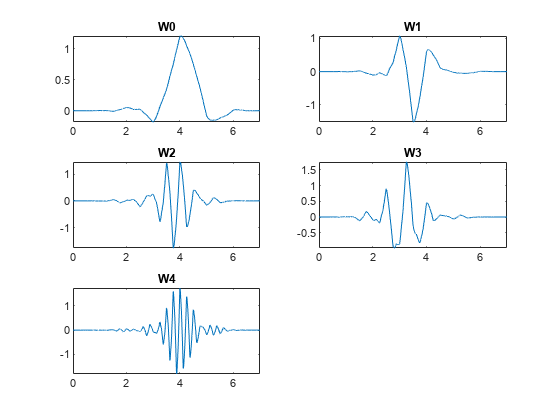Visualizing Wavelets, Wavelet Packets, and Wavelet Filters
This example shows how to use wfilters, wavefun, and wpfun to obtain the filters, wavelet, or wavelet packets corresponding to a particular wavelet family. You can visualize 2-D separable wavelets with wavefun2.
Obtain the decomposition (analysis) and reconstruction (synthesis) filters for the biorthogonal spline wavelet filters with 3 vanishing moments in the reconstruction filter and 5 vanishing moments in the decomposition filter.
[LoD,HiD,LoR,HiR] = wfilters('bior3.5'); subplot(2,2,1) stem(LoD,'markerfacecolor',[0 0 1]); title('Lowpass Decomposition Filter'); subplot(2,2,2) stem(LoR,'markerfacecolor',[0 0 1]); title('Lowpass Reconstruction Filter'); subplot(2,2,3) stem(HiD,'markerfacecolor',[0 0 1]); title('Highpass Decomposition Filter'); subplot(2,2,4) stem(HiR,'markerfacecolor',[0 0 1]); title('Highpass Reconstruction Filter');

Visualize the real-valued Morlet wavelet. There is no associated scaling function.
figure [psi,xval] = wavefun('morl'); plot(xval,psi,'linewidth',2) title('$\psi(x) = e^{-x^2/2} \cos{(5x)}$','Interpreter','latex',... 'fontsize',14);

Obtain the first 4 wavelet packets for the Daubechies least-asymmetric wavelet with 4 vanishing moments, sym4.
[wpws,x] = wpfun('sym4',4,10); for nn = 1:size(wpws,1) subplot(3,2,nn) plot(x,wpws(nn,:)) axis tight title(['W',num2str(nn-1)]); end
